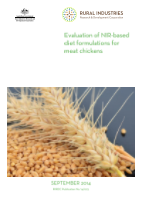Feed is the greatest single cost in the production of a meat chicken. Observed large variations in the efficiency of feed use, growth rate of birds and days to market can have a major impact on profitability. Research that results in either a reduction in this variability, through real-time quantification of essential nutrients within ingredients, or a reduction in ingredient cost, through a more reliable and diverse supply, would greatly benefit the poultry industry.
Cereal grains used by the poultry industry are known to vary widely in available energy and protein content which is often reflected as variation in bird performance because standardised ingredient values are used for ration formulation. In addition, the true available nutrient content of many grain parcels downgraded for human consumption is unknown; for example, pinched, high screenings, frosted and germinated grains. Rapid or real-time techniques for measuring the apparent metabolisable energy (AME) content and AME intake of grains for birds would greatly assist the purchase of grains at appropriate prices, facilitate improved accuracy of feed formulation and result in a reduced variability in nutrient supply across formulated batches of feed. Near infrared reflectance (NIR) methods are used widely in the animal feed and human food industries to indicate the nutritional quality of raw ingredients and processed products.





